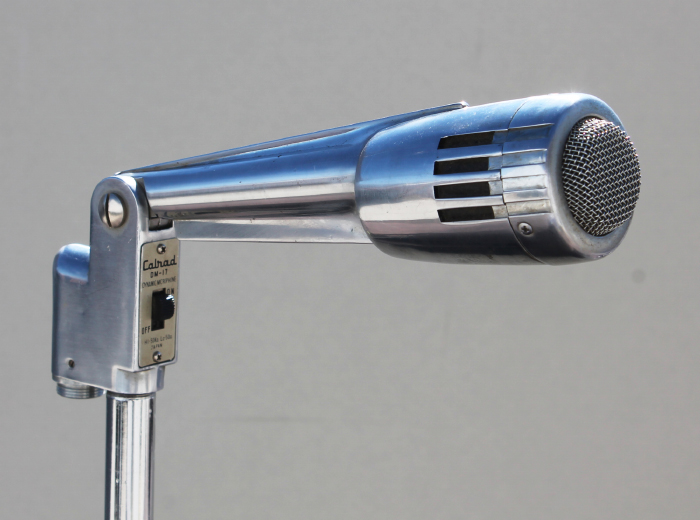As many of you know, I have a large vintage microphone collection and have written a several articles (available on ProSoundWeb) about some of the more interesting models in my collection. Aside from mics from Shure and Electro-Voice, the third most-represented brand in the collection is a company called Calrad Electronics.
While not a well-known name, Calrad is still going to this day, selling mics as well as other audio and electronic gear. I have dozens of vintage Calrad units dating from the late 1950s through the 70s.
An Interesting History
Calrad (the name comes from “California Radio”) was founded in the 1950s when the need for electronics greatly expanded after World War II, and it’s been owned by the same family ownership for more than 60 years. In the past, the company offered many different types of mics including models for radios, crystal and dynamic models for broadcast and recording as well as mics intended for live sound applications.
Calrad also provided small mic mixers, accessories such as desk stands, plugs and adapters, headphones, raw-frame loudspeaker transducers, loudspeaker systems, and power amplifiers. Also on the docket were a host of general electronic parts and even test gear like VOM meters.
Like many companies before the Internet age, Calrad produced catalogs showing its products. While I grew up on the East Coast and had never heard the before I started collecting mics, I did spend hours in my youth looking at electronic gear in other catalogs from companies like Radio Shack and Lafayette. (If I had lived on the West Coast, I’m sure I would have drooled over all the gear in the Calrad catalogs as well.)
The earliest Calrad catalog I own is number 37, published in 1960 or 61, and it lists 11 different crystal and dynamic models as well as two push-to-talk mics for Citizens Band (CB) radios along with a cool mic for acoustic stringed instruments. The company’s gear was also sold by a few other retailers – I own a few vintage Burstein-Applebee electronics catalogs that include some Calrad mics as well as mic mixers and accessories.
The current Calrad online catalog still shows audio items like amplifiers, some replacement loudspeakers and a lot of accessories like windscreens, mic stands and cables, but there’s only a single economy handheld dynamic mic.
Completing A Quest
One of the recent acquisitions for my collection is the Calrad DM-17, a stand-mounted dynamic model that was intended for speech, vocals and instruments. The catalog copy for it states, “Smooth natural sound on voice or music.”
I ran across this mic when I went to a house to look at some used equipment the owner had for sale. He seemed disappointed that I was more interested in the old DM-17 he had on display than I was in the more expensive guitar amplifiers he was selling, but after making a deal for a Fender amp plus the mic, he was happy. And I was more than happy because I’d been looking for a clean DM-17 for years.
It’s a good-looking example of a typical stand-mounted mic, with a base that screws directly to 5/8”-27 standard threads on a mic stand. The base also houses a four-pin screw-on audio connector as well as an on-off switch mounted on the base, facing the user.

The switch is surrounded by the name plate. Attached to the base by a swivel joint is the mic body, about seven inches long with a steel grill on the front as well as four slotted side ports on each side to facilitate a “pear shaped” (cardioid) pattern. A note in the catalog: “This microphone reproduces true sound with unwanted pickup eliminated from sides or rear due to a sensitive pear-shaped pickup pattern.”
The DM-17 is built like a tank, constructed of rugged metal with a satin chrome finish. With a very good-looking streamlined “Art Deco” style, it would not look out of place on a stage today. It’s a dual-impedance unit that shipped in high-impedance mode (50,000 ohms). The catalog explains that low-impedance (50 ohm) operation could be obtained by moving one wire. And, the mic shipped with a (pretty short) six-foot-long cable.

Striking Similarities
Like many other electronic companies in that era, Calrad seems to have had many – if not all – of its microphones made and badged in Japan. I own a lot of similar looking models that are different only in name and/or some cosmetic features.
Some of my Calrad models are identical to those badged as Olsen, Monarch, Tiesco, Fen Tone, Lafayette and Claricon. Looking at various vintage mics manufactured in Japan, some units even use the same model numbers even though they carry different brands.
Early Calrad microphone boxes shipped in cardboard cartons with lift-off-type lids. Most of mine have a blue lid and white box, but a few of are all white. In addition, two of them sport a gold color (the same gold as a few of my Radio Shack cartons), reinforcing that various mics and packaging were made in the same factories in Japan and re-badged.
No matter the lid color, early cartons carried a sticker with an orange color oval on a dark blue background. Smaller ones, where the sticker was also smaller, might just include the model name and impedance, while larger stickers might also list the contents and tell a little about the mic’s intended uses. No matter the size or content of the sticker, all models state “Made In Japan” on the label.
The Calrad DM-17 may not be weird looking or exotic like some of the other models in my collection but it’s a great example of a versatile rugged stage performer.
Calrad DM-17 Stated Specs
Frequency Response: 40 Hz – 15 kHz
Impedance: 50 Kohm or 50 ohm
Sensitivity -52 dB (at 1 kHz)
Price in the early 1960s: $16.95
Go here for more Microfiles articles from Craig.




















